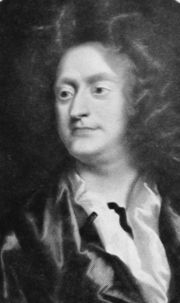Dido and Aeneas
2007 Schools Wikipedia Selection. Related subjects: Poetry & Opera
Dido and Aeneas is an opera by the English Baroque composer Henry Purcell, from a libretto by Nahum Tate. It was first performed in the spring of 1689 and hence is given catalogue number Z. 626. It comprises three acts and lasts about an hour.
It is based on a story from the fourth book of Virgil's Aeneid, of the legendary Queen of Carthage Dido and the Trojan refugee Aeneas. When Aeneas and his crew are shipwrecked in Carthage, he and the queen fall in love. However, Aeneas must soon leave to found Rome. Dido cannot live without him and awaits death.
This work is somewhat problematic, since no score in Purcell's hand is extant, and the only seventeenth century source is a libretto, possibly from the original performance. The difficulty is that no later sources follow the act divisions of the libretto, and the music to the prologue is lost. Part of this stems from the practice of the time of using such entertainments to add spice to another piece, such as a play, breaking up the original work and only using parts of it, rather than putting it on as a complete work.( pg. iv) It is a monumental work in the Baroque opera, remembered as one of Purcell's (and perhaps England's) foremost operatic works. It may be considered Purcell's only true opera, as compared with his other musical dramatic works such as King Arthur and The Fairy-Queen, as well as the first English opera. It owes much to John Blow's Venus and Adonis, including structure and overall effect.
Characters
- Dido - Queen of Carthage - soprano
- Belinda - Dido's handmaid - light soprano
- Aeneas - Trojan Prince - tenor
- Sorceress - mezzo-soprano ( counter-tenor)
- Spirit - in form of Mercury - soprano (counter-tenor)
- First Sailor - tenor
- First Witch - soprano
- Second Witch - soprano
- Second Woman - mezzo-soprano
- Chorus - SATB, all members at one point or another represent courtiers, witches, cupids, and sailors.
Libretto
Originally based on Nahum Tate's own play Brutus of Alba, or The Enchanted Lovers (1678), the opera is likely, at least to some extent, allegorical. The prologue refers to the joy of a marriage between two monarchs, which could refer to the marriage between William and Mary after the Glorious Revolution of 1688.
- In a poem of about 1686 Tate himself alluded to James II as Aeneas, who is misled by the evil machinations of the Sorceress and her witches (representing Roman Catholicism, a common metaphor at the time) into abandoning Dido, who symbolizes the British people. The same symbolism may apply to the opera.
This explains the addition of the characters of the Sorceress and the witches, which do not appear in the original Aeneid. It would be noble, or at least acceptable, for Aeneas to follow the decree of the Gods, but not so acceptable for him to be tricked by ill-meaning spirits.
Although the opera is a tragedy, there are numerous lighter scenes, such as when the First Sailor sings "Take a boozy short leave of your nymphs on the shore, and silence their mourning with vows of returning, though never intending to visit them more."
Score
The first of the arias to be published separately was "Ah, Belinda" in Orpheus Britannicus. The most famous aria of the work is Dido's lament, When I am laid in earth. Both arias are formed on a lamento ground bass. Dido's lament has been performed or recorded even by artists far from the typical operatic school such as Klaus Nomi (as "Death"), Ane Brun and Jeff Buckley. The music is thought by some to be too simple for Purcell in 1689, but this may simply reflect that the intended performers were schoolchildren. The original instrumentation is not at all clear, but it certainly included a continuo part. In answer to this Imogen Holst and Benjamin Britten put together an edition of the opera with a realization by Britten. Now there are a number of editions with realizations, which makes the piece much more accessible for amateur performance.(, pg. vi)
Recordings
Recordings include:
- Dame Janet Baker (Dido), Patricia Clark(Belinda), Raimund Herincx (Aeneas), supporting soloists, St. Anthony Singers, English Chamber Orchestra, Anthony Lewis, conductor. Recorded 1961 and re-released on Decca in 2000.
- Susan Graham (Dido), Ian Bostridge (Aeneas), Camilla Tilling (Belinda), Felicity Palmer (Sorceress), David Daniels (Spirit), Cécile de Boever (Second Woman), Paul Agnew (A Sailor), Emmanuelle Haïm (conductor), European Voices, Le Concert d'Astrée. Virgin Veritas 45605
- Emma Kirkby (Dido), Judith Nelson (soprano), David Thomas (bass), Taverner Consort and Players conducted by Andrew Parrott, Chandos CHAN 8306.
- Discography
